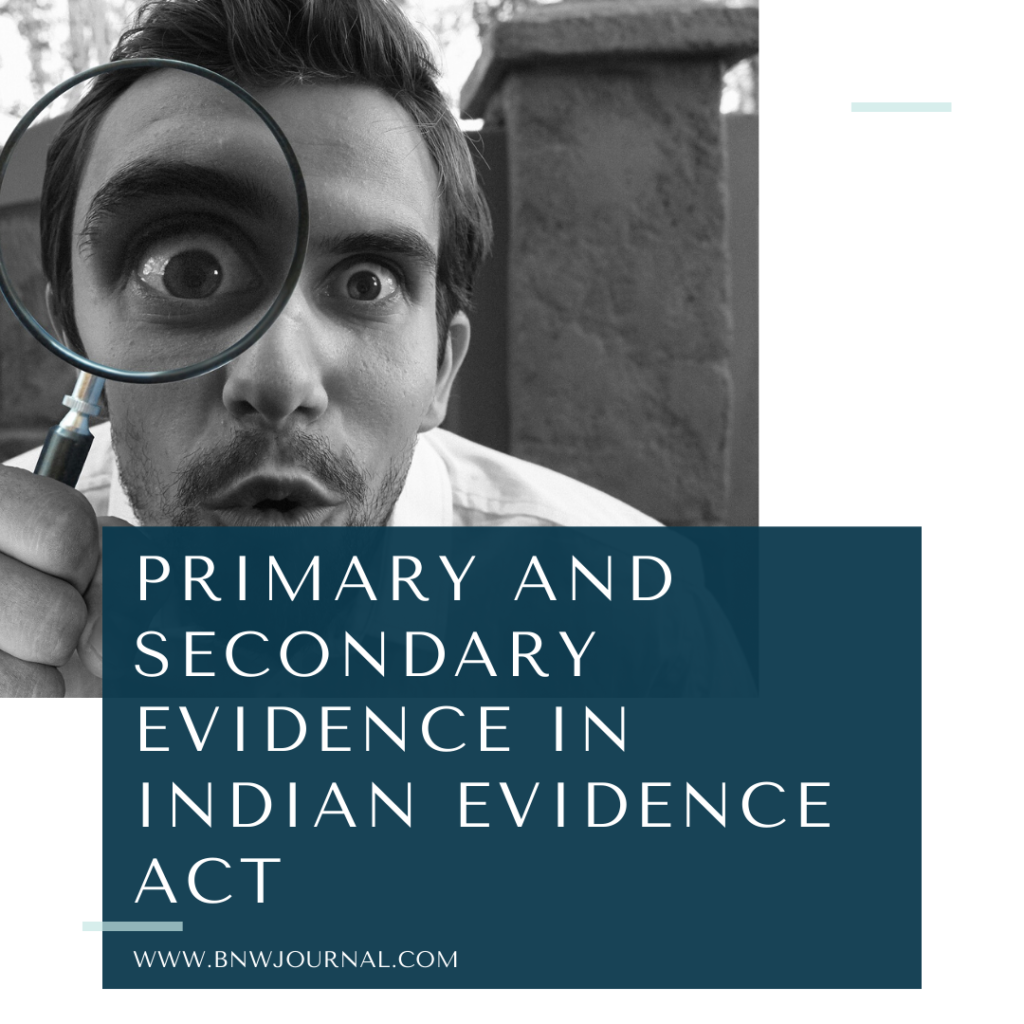![]()
Primarily evidence can be classified into a primary or a secondary kind of evidence. This article discusses about them both in detail and underlines the important facts about them.

PRIMARY EVIDENCE
Section 62 of the Indian Evidence Act states what all can be considere as primary evidence. Under the Indian Evidence Act following documents are consider to be primary evidence:
- The original document itself which has been produced before the court. C.P.Agarwal v. P.O., Labour court[1]
- Each part of a document is consider as primary evidence if the document has been execute separately. This has been stated in the case Shiv Kant Pandey v. Ishwari Singh[2]
- Where a document is execute in counterparts each part is consider as primary evidence against the party who sign in it.
- Where the document has been made in the same process i.e. in the case of newspapers, photography or lithography each document is consider as a primary evidence in the eye of law. This is because they have been made at the same time and no variation can be expect. Kamla Rajamanikham v. Sushila Thakur das[3]
Primary evidence is the document which according to Indian Law should be given first to the court. One with the most evidentiary value. This is based on the concept of best evidence. It is generally considere the primary evidence is the accurate evidence. This is because the primary document is the first permanent record of a transaction that happened. It is first-hand evidence and hence it is presume that the primary evidence is the most reliable. The other documents i.e. the secondary evidence can be altere or interline as a result of becoming less reliable. Hence it is always better to have the original or primary evidence to check if any alterations have been made to the document subsequently.Case laws-
In the case of Murarka Properties v. Beharilal Murarka it has been stated, “The contents of every written paper are, according to the ordinary well-established rules of evidence, to be proved by the paper itself, and by that alone, if the paper is in existence”.[4]
This can be seen in the case Vinod Chaturvedi v. State of M.P,[5] of where the court held a letter to be non-reliable where the opposite party was allowed to cross-examine the writer of the letter as a witness. But this is not always the case contents of a document can also be prove by other evidence. And not exactly by bringing the author of the document as a witness, this has been stated in the case Ramji Dayawala v. Invest Import.[6] Even if the person doesn’t deny the truth that has been given in the document, it cannot be considered as evidence against him until the facts in the document have been proved, S.A. Khan v. Bhajan Lal.[7]
PROOF OF DOCUMENTS BY PRIMARY EVIDENCE
Section 64 of the Indian Evidence Act states that a document must in all cases be prove using the primary evidence except in cases which are mention under the act. This section embodies the same principles that have been stat earlier, the primary evidence presume to be the ‘best evidence’. Section 65 states the different cases where secondary evidence can be submitted this is because if only primary evidence can be produced it will defeat justice when most people won’t have the primary document.
Usually it is follow that any objections about proving documentary evidence should be in the trial stage of the case itself. In the case of State of Haryana v. Chandji,[8] it was held if no objections have been given to the documentary evidence in the trial stage, in the stage of appeal, the objection will be too late. In this case Vinod Chaturvedi v. State of M.P,[9] the document produced was the primary document. In the case where a secondary document is produce which is a copy of insurance policy during the trial and opposite party did not object to the same, the appellate court still allowed the objection of exclusion of the same in appeal.
SECONDARY EVIDENCE
Section 63 of the Indian Evidence Act states and defines what can be consider as a secondary document. Following Documents are secondary evidence:
- Copies made from the process by mechanical process
- Copies made from or compared with the original;
- Counterparts of documents as against the parties who did not execute them;
- Oral accounts of the contents of a document given by some person who has himself seen it.
In secondary evidence even the oral account of the documents will be consider but two conditions must be satisfy for considering the relevancy of such documents. The first consideration is that the party offering the oral evidence must be entitle to give secondary evidence of such document as stated in Section 65 of the Indian Evidence Act which states conditions where the secondary evidence can be given. The second condition is that the oral document must be by the person who has seen the contents of the document. He must have seen it. If these conditions are satisfied the oral evidence with regards to the contents of the document will be taken into consideration
“The rule is, that if you cannot produce the original, you may give parol evidence of its contents if indeed the party giving such parol evidence appears to have better secondary evidence in his power, which he does not produce, that is a fact to go to the jury, from which they might sometime presume that the evidence kept back would be adverse to the party without holding it. But the law makes no distinction between one class of the secondary evidence and another.”[10]
PROOF OF DOCUMENTS BY SECONDARY EVIDENCE
Section 65 of the Indian Evidence Act lays down cases where secondary evidence may be accepted.
- when the document is with the opposite party or person out of reach or not subject to the court process or person legally bound to produce it.
- When condition or content of the original has been proved to be admitted in writing by opposite party
- If the primary evidence has been lost or destroyed or party offering is not able to produce it as a result of some other reason or neglect.
- Primary evidence is not easily movable
- It is a public document under Section 74
- It is permitted by the Indian Evidence Act or any other law to submit it as a certified copy.
- When primary evidence contains other documents or numerous account which cannot be examined in court conveniently
When it comes to the admissibility of secondary evidence, the party that is proving the secondary evidence must make out its relevancy. In the case of Hadiani Debi v. Kailash Panda,[11] it was held that if secondary evidence is produced without laying down a foundation for the same even the production of certified copies also will not be allowable evidence.
DIFFERENCE BETWEEN PRIMARY AND SECONDARY DOCUMENTS
- Primary evidence is the original document submitted to the court for inspection while the secondary document is a copy of the original document
- Primary evidence is presumed to be the best evidence in all circumstances while secondary evidence can only be taken into consideration during cases listed under section 65
- Production of primary evidence is the general rule while the secondary evidence production is an exception
- Primary evidence has the highest evidentiary value as compared to secondary evidence
- Notice is not required while submitting primary evidence but is required when submitting secondary evidence.
References:
[1] (1996) 11 S.C.C. 393
[2] AIR 1997 Raj 155
[3] AIR 1983 All. 90
[4] (1978) 1 S.C.C. 109
[5] AIR 1984 S.C. 911
[6] AIR 1981 S.C. 2085
[7] AIR 1993 S.C. 1348
[8] AIR 1982 P& H 282
[9] AIR. 1984. S.C. 911
[10] LORD ABINGER, C.B. in Doerd Gilbert v. Ross, (1840) 19 L.J. Ex.210
[11] (2004) 2 S.C.C. 544 Ori



0 Comments